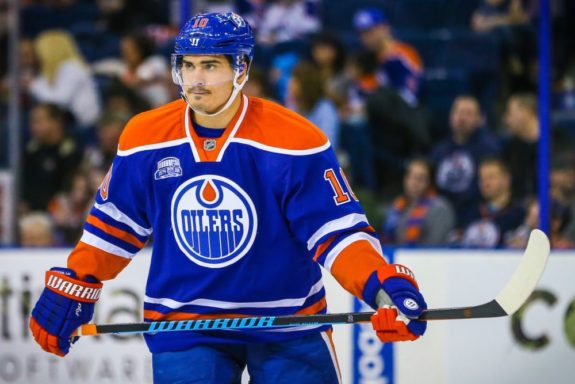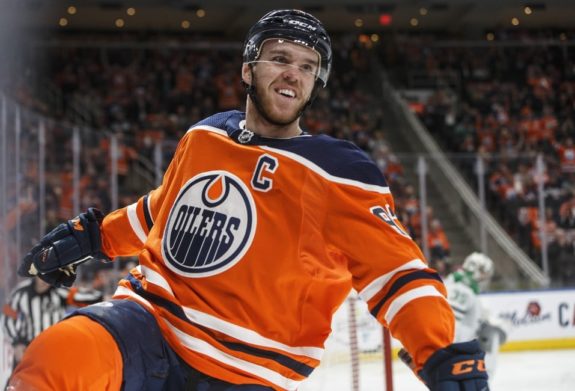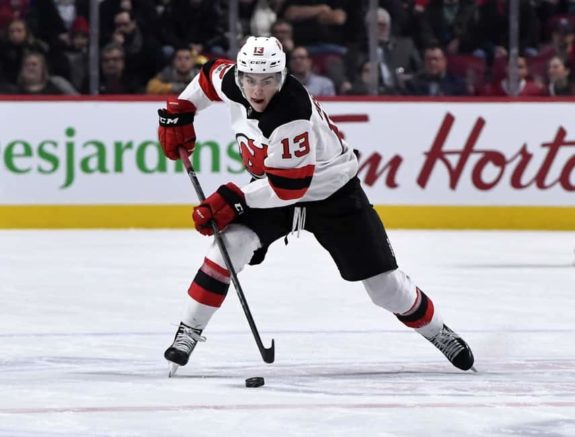For the second time in three years, the New Jersey Devils had the first overall selection at the NHL Entry Draft. They used it to select center Nico Hischier in 2017 and followed it up by drafting center Jack Hughes from the U.S. National Development Program this past June.
There are plenty of expectations that come with being the first overall pick, even as a rookie. So what should the Devils expect from the 18-year-old center? Here’s how the last five forwards selected first overall at the NHL Entry Draft fared during their first NHL seasons.
Nail Yakupov (2012-13, Edmonton Oilers)
Counting totals: 31 points (17 goals, 14 assists), 48 games played
5-on-5 numbers: 42.47 Corsi for percentage (CF%), 39.69 expected goals for percentage (xGF%), 51.06 goals for percentage (GF%), 2.14 points per 60 min. (P/60), 1.82 primary points per 60 min. (P1/60)
Yakupov was the third of what was a slew of first overall picks for the Oilers, with Ryan Nugent-Hopkins and Taylor Hall preceding him. He played in just 48 games as a rookie due to the lockout-shortened NHL season, and it was quite the mixed bag. He produced at a 52.9-point pace over 82 games, but his 5-on-5 shot rates were more than underwhelming.

His CF% of 42.47% was among one of the worst on the team, and his 51.06 GF% was almost 12% higher than his xGF%. The Oilers were far from a great team in 2012-13, but those are still pretty rough numbers for a first overall pick. Maybe it was a sign of things to come as his play regressed in the following seasons. But as we’ll see in a bit, Yakupov is an outlier compared to the other forwards.
Nathan MacKinnon (2013-14, Colorado Avalanche)
Counting Totals: 63 points (24 goals, 39 assists), 82 games played
5-on-5 numbers: 46.83 CF%, 44.86 xGF%, 47.22 GF%, 2.07 P/60, 1.40 P1/60
MacKinnon followed Yakupov as the first overall pick in 2013. He had an immediate impact and helped the Avalanche find their way back to the playoffs. He also added the Calder Trophy to his name as the NHL’s Rookie of the Year for 2013-14. In terms of 5-on-5 scoring, MacKinnon underperformed Yakupov by a bit. On the other hand, his shot rates were much better.
Related: Colorado Avalanche Select Nathan MacKinnon With Top Pick
A 46.83 CF% and 44.86 xGF% may not seem great, but there are a couple of things to note. It’s easy to say in hindsight, but the Avalanche were not done any favors by Patrick Roy, who was their head coach at the time, as they had some of the worst shot rates in the NHL. Since his departure in Aug. 2016, MacKinnon’s shot rates have improved by quite a bit, so the change in coaches has had a positive effect.
It’s also safe to say that if you saw MacKinnon play as a rookie, his potential was quite clear. Winning the Calder Trophy wasn’t an accident. He was and still is an elite skater, and he had a positive impact when on the ice. That’s why he’s become one of the best centers in the game.
Connor McDavid (2015-16, Oilers)
Counting Totals: 48 points (16 goals, 32 assists), 45 games played
5-on-5 numbers: 51.28 CF%, 56.3 xGF%, 50.72 GF%, 2.69 P/60, 2.02 P1/60
There was much fanfare around McDavid in his draft year as most scouts touted him as the best prospect available since Sidney Crosby was drafted first overall by the Pittsburgh Penguins. And it took almost no time for him to prove the scouts right in his first season with the Oilers. He played in just 45 games due to a broken collarbone he suffered early in the season, but his numbers were still stellar.

His 2.69 P/60 ranked second in the league to Jaromir Jagr, while his P1/60 ranked sixth in the league. His shot rates were among the team’s best, and the Oilers even underperformed when he was on the ice, with his xGF% being six percent higher than his actual GF%. Had he played a full season, he would’ve been on pace to finish with 87 points, and he probably would’ve been a good bet to win the Calder Trophy, too.
Auston Matthews (2016-17, Toronto Maple Leafs)
Counting totals: 69 points (40 goals, 29 assists), 82 games played
5-on-5 numbers: 51.39 CF%, 51.7 xGF%, 51.06 GF%, 2.12 P/60, 1.91 P1/60
Matthews was the last American taken with the first pick before Hughes selection. However, he took a different route to the NHL than Hughes, who played his amateur hockey in the USHL and with the U.S. U-18 National Team. Matthews, instead, played a year with ZSC Lions in the NLA (Switzerland), where he had 46 points in 36 games. That one-year stint in a pro league seemed to help him as his transition to the NHL was seamless.
Matthews had an immediate impact with the Leafs. He finished his rookie season with 40 goals and was a force at 5-on-5. His average of 2.12 P/60 put him ahead of names like Alex Ovechkin, Leon Draisaitl, and Mark Stone. He also performed close to expectations, with his xGF% and GF% being close to even. He finished the season hoisting the Calder Trophy while helping the Leafs make the playoffs for the first time since 2012-13.
Nico Hischier (2017-18, Devils)
Counting Totals: 52 points (20 goals, 32 assists), 82 games played
5-on-5 numbers: 49.98 CF%, 51.29 xGF%, 56.62 GF%, 2.40 P/60, 2.06 P1/60
After one of the worst seasons in franchise history, the Devils had luck on their side and won the Draft Lottery to select first overall in 2017. It wasn’t one of the strongest draft classes, with most pundits narrowing the top pick down to Nolan Patrick or Hischier. The Devils ended up going with the latter, making Hischier the first Swiss player ever to be selected with the top pick.

The organization seems to have made the right choice. Hischier may not have won the Calder Trophy, but it was clear the Devils had the makings of a top-six center on their hands. He finished with 52 points, and his 5-on-5 scoring rates were better than those of Matthews, MacKinnon, and Yakupov. They also had no problem giving him top-line minutes, which he played throughout the season. And he was a big reason why the Devils’ clinched their first postseason berth since their run to the Stanley Cup in 2011-12.
How Will Hughes Fare?
Every player is different, so it doesn’t mean he’ll produce exactly like previous first overall picks. With that said, there are some common denominators among all five forwards. And they could help give a barometer of what Hughes may do when he hits the ice for the first time.
For starters, all the players had similar scoring rates. Each averaged between 2.00-2.50 P/60 while finishing in between 50-70 points for the season. This is even true for Yakupov, who produced at a 52-point pace in his first season. The only exception is McDavid, who was another level as a rookie. Three of the five (Hischier, Matthews, and MacKinnon) also helped their teams reach the playoffs in their first seasons.
Related: Devils’ Roster Is Built to Contend
So what should expectations be for Hughes? A season like McDavid’s seems unlikely, although, it’s not impossible. He’s a generational talent, and not many rookies produce at an 87-point pace. Matthews scored 40 goals as a rookie, and Hughes is a pass-first player, so that seems unlikely, too.
MacKinnon and Hischier offer the best comparables for Hughes. MacKinnon finished with 24 goals and 63 points, while Hischier had 20 goals and 52 points. Anywhere around 55-65 points, while averaging close to 2.00 P/60 at 5-on-5, seems like a reasonable target for Hughes. He’s going to play in favorable offensive situations, so he’ll have a good shot at getting there and could surpass it. If that’s the case, he’ll have a chance at winning the Calder Trophy, and maybe he helps get the Devils to the playoffs, too.
* * *
Advanced stats from Corsica Hockey